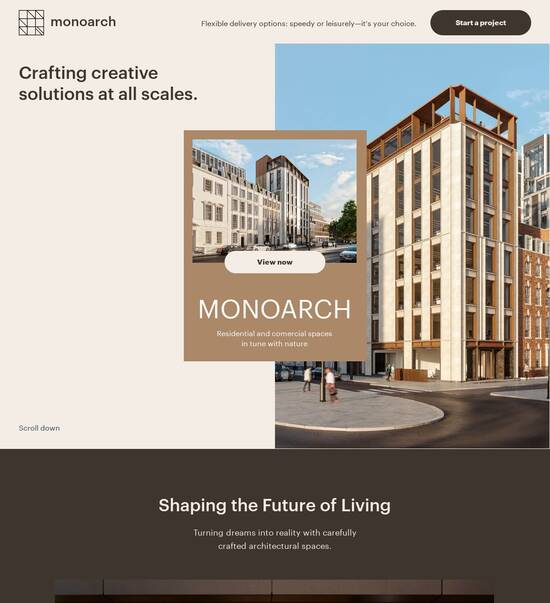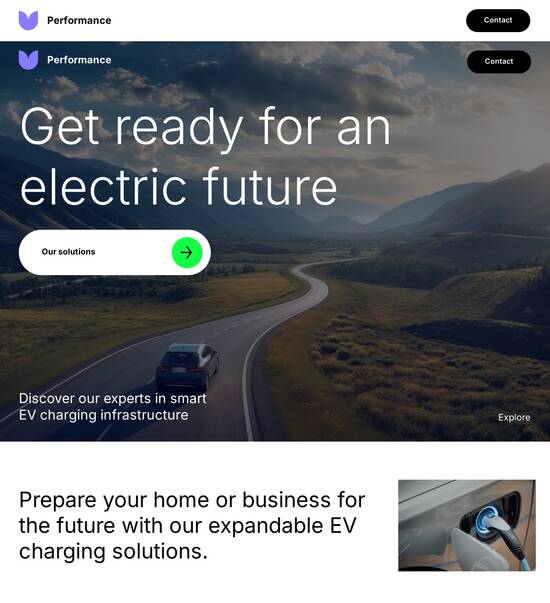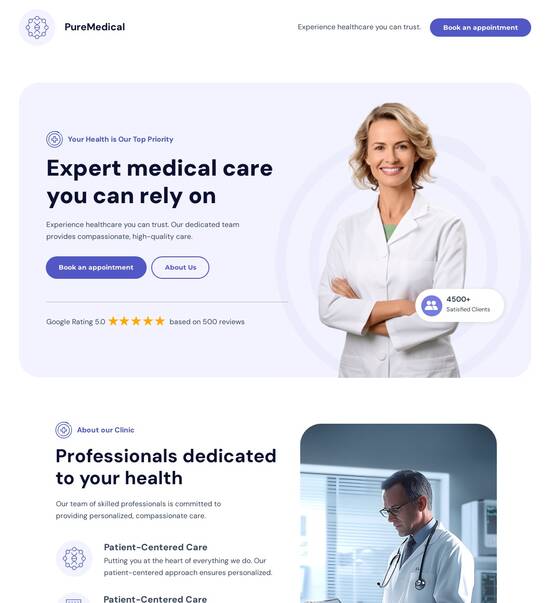
HTML page template for Route drivers
Use TemplateAbout template
Attract clients and showcase your skills with style using our landing page templates for Route drivers. Let's convert those visitors into clients!
Recommended templates

Easy to build without coding
With the intuitive drag-and-drop builder, anyone on your team can create high-converting pages without any knowledge of code or design. Make enhancements to your landing page with custom widgets using Javascript, HTML/CSS, or third-party scripts.

Multiple layouts for any industry and goal
Select from 500+ landing page layouts built to boost conversions across industry-specific scenarios. Customize them by adjusting fonts, adding images, and generating on-brand content with the AI assistant. Quickly scale with Instablocks® and Global Blocks that you can save, reuse, and update globally.

Loads fast and looks polished on any device
Every template is responsive, which means they present professionally on any device and load blazingly fast with our Thor Render Engine. You can also power them up with Google AMP technology to deliver an unparalleled mobile experience and drive higher conversions.

Robust analytics & experimentation
Get real-time updates and reporting across all your devices, showing the number of visitors, conversions, cost-per-visitor, and cost-per-lead. Launch AI-powered experiments, run A/B tests, and use heatmaps to analyze user behavior, then optimize your landing page to maximize conversions.







Easy to build without coding
With the intuitive drag-and-drop builder, anyone on your team can create high-converting pages without any knowledge of code or design. Make enhancements to your landing page with custom widgets using Javascript, HTML/CSS, or third-party scripts.
Multiple layouts for any industry and goal
Select from 500+ landing page layouts built to boost conversions across industry-specific scenarios. Customize them by adjusting fonts, adding images, and generating on-brand content with the AI assistant. Quickly scale with Instablocks® and Global Blocks that you can save, reuse, and update globally.
Loads fast and looks polished on any device
Every template is responsive, which means they present professionally on any device and load blazingly fast with our Thor Render Engine.
Robust analytics & experimentation
Get real-time updates and reporting across all your devices, showing the number of visitors, conversions, cost-per-visitor, and cost-per-lead. Launch AI-powered experiments, run A/B tests, and use heatmaps to analyze user behavior, then optimize your landing page to maximize conversions.
All the features you need to build lead-generating landing pages
Explore more featuresLearn how to build top-performing landing pages for any goal
FAQs
Leading the way in building high-performing landing pages





An effective landing page and CRO platform for marketers
Instapage stands out as the most powerful landing page and conversion rate optimization (CRO) platform, designed specifically for marketers looking to accelerate and optimize their digital campaigns. With its robust set of features, Instapage helps businesses across various sectors, from tech and education to financial services, maximize their ROI efficiently.
Why choose Instapage for landing page creation?
Instapage offers a user-friendly platform filled with over 100 ready-to-use, high-converting templates that make launching campaigns a breeze. Whether your team is small or part of a large organization, the intuitive drag-and-drop interface ensures that no coding skills are needed, allowing marketers to focus on what truly matters – capturing leads and driving results.
- Diverse Templates: Choose from over 100 conversion-focused layouts tailored to different industries.
- Easy Customization: Instablocks allow for quick edits and adaptations, ensuring that pages align perfectly with campaign goals.
- Lead Generation Tools: Built-in lead generation elements to help capture more leads effortlessly.
Step 1: Optimize landing pages for higher conversions
Getting the most out of your landing pages involves optimization. With Instapage, you can utilize built-in experimentation features such as heatmaps and A/B tests. These tools provide insights into user behavior and performance metrics, guiding you in making necessary adjustments.
Step 2: Create personalized user experiences
Personalization helps in engaging distinct audience segments effectively. Instapage enables dynamic text replacement, allowing content to be tailored specifically to the audience’s needs and motivations.
- Dynamic Text Replacement: Allows for custom messaging based on where visitors came from.
- AdMaps: Align specific ads with landing pages to ensure continuity in user experience.
- Audience Metrics Tracking: Insights on how different audience segments interact with your content.
Step 3: Collaborate and speed up production
Collaboration tools in Instapage facilitate instant feedback and real-time edits among team members, enhancing workflow and ensuring that stakeholders can easily view and comment on landing pages.
- Real-time Editing: Collaborate with team members on-the-fly to streamline the creation process.
- Secure Sharing: Effortlessly share pages with external stakeholders for feedback without compromising security.
- Instant Feedback Mechanism: Enhance communication and reduce revision times significantly.
In summary, leveraging Instapage equips marketers with unparalleled tools to create, optimize, personalize, and collaborate on landing page experiences, ultimately driving more effective marketing outcomes.
To start transforming your campaigns today, sign up for a free trial of Instapage and experience the unique advantages of an all-in-one landing page and CRO platform.
People also ask about HTML page template for Route drivers
HTML page template for route drivers
Understanding the needs of route drivers
Route drivers have unique challenges that require tailored solutions to enhance their daily operations. Understanding these challenges begins with recognizing the complexities of their role, which encompass navigating traffic, managing tight schedules, and maintaining clear communication with dispatchers and customers. Each of these factors presents obstacles that can significantly impact their performance.
One primary concern for route drivers is time management. They often operate under strict deadlines, making efficient use of every minute essential. Navigational difficulties can arise from unplanned detours, traffic conditions, or road closures, complicating their routes and potentially delaying deliveries. Additionally, communication gaps with dispatch and customers can lead to misunderstandings about delivery times or locations, further complicating their responsibilities.
Time management issues can lead to missed delivery windows.
Navigational difficulties may cause inefficiencies and added stress.
Communication gaps can result in negative customer experiences.
An optimized HTML page template serves as a practical solution to address these issues effectively. Such a template can enhance efficiency and productivity by providing route drivers with easy access to critical information, allowing them to stay informed and adapt to changes quickly.
Key features of an HTML page template for route drivers
A compelling HTML page template for route drivers should prioritize user-friendliness to accommodate the bustling pace of their work. An intuitive navigation layout ensures that drivers can access the information they need without wasting precious time. Mobile responsiveness is equally important, as many drivers rely on mobile devices to access relevant details while on-the-go. The design should facilitate quick navigation to vital features such as route maps, delivery schedules, and communication tools.
Customization is another crucial aspect. Delivery companies often want a distinct branding identity, and the ability to personalize themes allows them to make the template align with their brand image. By offering pre-built themes catering to various industries, an HTML template can cater to diverse business needs, enhancing relevance and user experience.
User-friendly interface for easy navigation.
Mobile responsiveness for on-the-go access.
Customizable themes to match branding.
Moreover, integrating popular mapping services like Google Maps or Waze supports real-time route optimization. This accessibility to mapping features ensures route drivers can adapt instantly to changing conditions, providing them with the most effective paths for their deliveries.
Development of the HTML page template
Creating an effective HTML page template for route drivers involves careful coordination between designers and engineers. This collaborative process emphasizes the importance of understanding the needs of end-users, enabling the creation of features that directly address the challenges faced by route drivers. Engaging with drivers during development provides invaluable feedback, ensuring that the template not only meets but anticipates their needs.
Front-end development utilizes modern technologies like HTML5, CSS3, and JavaScript, which play a fundamental role in building a responsive and visually appealing design. Furthermore, back-end support is essential for data integration, allowing for the continual development of features based on real-time feedback and route analytics.
Collaboration between designers and engineers is crucial.
Feedback from route drivers enhances usability.
Front-end technologies include HTML5, CSS3, and JavaScript.
Additionally, responsive design principles ensure that the template is accessible across various devices, which is particularly important for route drivers who may use smartphones or tablets while on their routes. Performance optimization further assists in delivering quick load times and improving user experience.
Operational benefits of the template for route drivers
Streamlined communication tools included in the HTML template can significantly improve daily operations for route drivers. Incorporating built-in messaging functionality allows drivers to communicate effectively with dispatch teams and customers, thus bridging communication gaps previously experienced. Notifications for route changes or dispatch updates provide instant alerts that ensure drivers are always informed, adapting quickly to any changes in their schedule.
Moreover, documentation and reporting features can alleviate the administrative burden placed on drivers. Templates for delivery receipts and invoices help standardize documentation, making the end-of-day reporting straightforward. The ability to auto-summarize delivery logs saves time and ensures accuracy, freeing drivers to focus on the road rather than paperwork.
Built-in messaging tools facilitate quicker responses.
Notifications keep drivers updated on route changes.
Templates streamline documentation and reporting.
The HTML template also enhances safety and compliance. Features to report vehicle maintenance issues allow drivers to track vehicle health issues proactively. Compliance checklists embedded in the template ensure that drivers adhere to delivery regulations, thereby minimizing the risk of violations and enhancing overall safety.
Support and help resources for users
To ensure users derive maximum benefit from the HTML page template, a comprehensive help center is essential. This center should include guides and tutorials that offer step-by-step instructions for customizing templates according to specific needs. Frequently Asked Questions (FAQs) addressing common concerns from route drivers can also enhance usability and provide immediate answers to inquiries.
Dedicated support from the development team is equally vital for long-term success. Providing channels for technical assistance, such as email and live chat, establishes a foundation for timely responses to user issues. Having access to support ensures that any hiccups in the template don’t impede drivers' productivity and efficacy.
A help center with guides and tutorials helps users.
Dedicated support channels ensure timely assistance.
User forums foster community engagement and sharing.
Community engagement is another layer of support that can enhance user experience. User forums facilitate the sharing of best practices and allow drivers to connect with peers. Regular updates based on user feedback ensure that the template continues to evolve and adapt to their needs.
Strategies for maximizing the template’s efficiency
To maximize efficiency from the HTML page template, consideration of best practices for customization is essential. Drivers and companies should personalize layouts and themes to reflect their branding, which not only improves visibility but also creates a sense of ownership among drivers. Utilizing built-in analytics can provide insights into page performance, allowing teams to make informed adjustments that align the template with operational goals.
Combining features effectively can result in greater overall impact. For example, integrating real-time data with reporting tools allows for immediate adjustments based on delivery conditions, while user inputs can refine communication strategies to better serve customers and assist drivers. The integration of these elements creates a dynamic environment for improvement.
Best practices include personalizing layouts and applying analytics.
Combining real-time data with reporting tools increases effectiveness.
Testing functionalities before full implementation is crucial.
Testing and iteration are key elements in refining the template. By rigorously assessing functionalities before full implementation, organizations can identify potential issues early. Ongoing gathering of user feedback facilitates constant improvements, reinforcing the template's alignment with the evolving needs of route drivers.
Addressing potential concerns and misconceptions
Route drivers often have concerns regarding data privacy and spam, particularly when using a digital platform for their daily operations. Addressing these concerns necessitates a clear understanding of data security measures employed within the template. Providing transparency about how data is handled and shared can significantly boost users' confidence in the system's reliability.
The perceived value of the template must also be contrasted with its actual benefits. It's essential to distinguish between basic templates and those that offer advanced features tailored for complex operations. Sharing real-world return on investment (ROI) stories from companies that have successfully adopted the template can further highlight its value.
Addressing privacy concerns about data handling is essential.
Education on the benefits versus basic features aids decision making.
Showcasing real-world ROI emphasizes value.
By proactively addressing these concerns, the template can position itself as a trustworthy resource for route drivers, ensuring they feel secure in its implementation and use.
Exploring discounts and incentives for adoption
To encourage adoption of the HTML page template, various promotional offers can be implemented, particularly for early adopters. Providing special discounts for new customers creates an incentive to join the platform. These promotional offers not only enable organizations to explore the template’s features at a reduced cost but also help establish a client base quickly.
Referral bonuses serve as another method to boost engagement. Encouraging existing route drivers to share the template with their teams can enhance adoption rates while rewarding them for their efforts. This strategy builds a sense of community while expanding the user base.
Special discounts for early adopters incentivize quick adoption.
Referral bonuses encourage team engagement.
Corporate packages can provide bulk rates for large teams.
Corporate packages tailored for larger teams allow companies with extensive delivery fleets to tap into additional features at discounted rates, encouraging bulk buying as a cost-saving strategy. This collaborative approach can further strengthen relationships within the industry.
Appreciating collective efforts and team synergy
Recognizing the contributions of development engineers is essential when discussing the success of the HTML page template. Insights from the engineering team regarding template design provide valuable context about the thought process behind the features included. Hearing quotes from team members can illuminate their motivations and dedication to innovation within the template’s development process.
Furthermore, feedback plays a crucial role in shaping future updates. The perspectives of route drivers should be prioritized, as they offer frontline insights into the template's performance and usability. Planning for future enhancements that incorporate user experiences will help ensure that the product continually meets the evolving demands of the industry.
Acknowledging engineers' contributions fosters a sense of pride.
Driver feedback is integral for ongoing enhancements.
Community success stories highlight effective use of the template.
Celebrating success stories from within the community reinforces the effectiveness of the template. Highlighting testimonials from satisfied users not only builds trust but also encourages others to adopt similar solutions. Recognizing exemplary route drivers or companies who have effectively leveraged the template further showcases the tangible benefits achieved within the industry.
Ready to skyrocket conversions?
Supercharge your ad campaigns with high-performing landing pages
Get started














